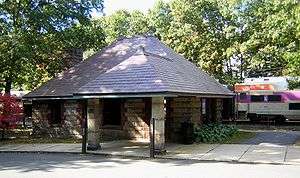Wellesley Farms station
Wellesley Farms is an MBTA Commuter Rail station in Wellesley, Massachusetts. It serves the Framingham/Worcester Line. It is located in the Wellesley Farms area. The current station building, designed by Henry Hobson Richardson in 1886 and constructed in 1890, has been listed on the U.S. National Register of Historic Places as Wellesley Farms Railroad Station since 1986.[2]
Wellesley Farms | |||||||||||||
|---|---|---|---|---|---|---|---|---|---|---|---|---|---|
 Wellesley Farms station in 2009 | |||||||||||||
| Location | 90 Croton Street, Wellesley, Massachusetts | ||||||||||||
| Coordinates | 42°19′23.5″N 71°16′19″W | ||||||||||||
| Owned by | Town of Wellesley | ||||||||||||
| Line(s) | Worcester Line | ||||||||||||
| Platforms | 2 side platforms | ||||||||||||
| Tracks | 2 | ||||||||||||
| Construction | |||||||||||||
| Parking | 199 spaces ($4.50 daily) | ||||||||||||
| Bicycle facilities | 16 spaces | ||||||||||||
| Other information | |||||||||||||
| Fare zone | 3 | ||||||||||||
| History | |||||||||||||
| Opened | 1830s | ||||||||||||
| Rebuilt | 1890 | ||||||||||||
| Previous names | Rice's Crossing | ||||||||||||
| Traffic | |||||||||||||
| Passengers (2018) | 298 (weekday average boardings)[1] | ||||||||||||
| Services | |||||||||||||
| |||||||||||||
| |||||||||||||
Wellesley Farms Railroad Station | |||||||||||||
  | |||||||||||||
| Location | Croton Street Extension, Wellesley, Massachusetts, USA | ||||||||||||
| Area | 2.1 acres (0.85 ha) | ||||||||||||
| Built | 1890 | ||||||||||||
| Architect | H.H. Richardson | ||||||||||||
| Architectural style | Romanesque, Richardsonian Romanesque | ||||||||||||
| NRHP reference No. | 86000259[2] | ||||||||||||
| Added to NRHP | February 14, 1986 | ||||||||||||
History
The Boston & Worcester Railroad (B&W), extending outwards from Boston, reached through the West Parish of Needham in mid-1834.[3] Rice's Crossing station opened as a flag stop north of Glen Road soon afterward.[4] In 1839, the line was double tracked through the area.[5]
Wellesley Farms station, which was designed by Henry Hobson Richardson prior to his death in 1886, opened south of Glen Road to replace Rice's Crossing in 1890.[4] Like many B&A stations, it had attractive landscaping; Charles Mulford Robinson called it "unique, and to be remembered" in 1904.[6]
The station was added to the National Register of Historic Places in 1986.[2] In July 2004, the MBTA closed a paved crossing between the crossings in response to concerns about safety. Similar crossings exist at some other MBTA stations, but the agency's policy is to eliminate grade crossings whenever possible when building or renovating stations.[7]
References
- Central Transportation Planning Staff (2019). "2018 Commuter Rail Counts". Massachusetts Bay Transportation Authority.
- "National Register Information System". National Register of Historic Places. National Park Service. March 13, 2009.
- Humphrey, Thomas J. & Clark, Norton D. (1985). Boston's Commuter Rail: The First 150 Years. Boston Street Railway Association. pp. 21–25. ISBN 9780685412947.
- Fiske, Joseph E.; Ellen W. Fiske (1917). History of the Town of Wellesley, Massachusetts. Boston, Chicago: The Pilgrim Press. p. 26. OCLC 6541911 – via Internet Archive.
- Karr, Ronald Dale (1995). The Rail Lines of Southern New England. Branch Line Press. pp. 278–283. ISBN 0942147022.
- Robinson, Charles M. (1904). Boston & Albany Railroad: Suburban Station Grounds. H. T. Coates. OCLC 25110729 – via Internet Archive.
- Shartin, Emily (25 July 2004). "Convenience loses out to safety at rail station". Boston Globe. Retrieved 4 March 2016.
External links
![]()
- MBTA - Wellesley Farms
- Google Maps Street View: Croton Street entrance, Glen Road entrance, Hundreds Road entrance
